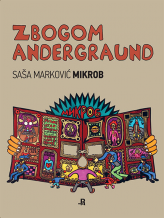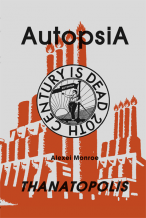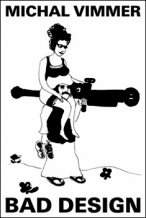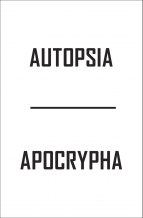There’s 130 kilos of fat, muscles, brain & raw power on the Serbian contemporary art scene, all molded together into a 175-cm tall, 44-year-old body. It’s owner is known by a countless number of different names, including Bamboo, Mexican, Groom, Big Pain in the Ass, but most of all he’s known as MICROBE!… Hero of the losers, fighter for the rights of the dispossessed, folk artist, entertainer of the petit bourgeoisie, home anarchist, record collector, pussy lover & founder of the secret organization KPGS:
“In May 1987, my old friend Nebojša Kandić-Dudek introduced me to the fabulous Antonio Pušić [at that time a totally unknown freak from Montenegro who, a year later, became a rock 'n' roll superstar known by his alter ego: Rambo Amadeus. Note – U. Dj.]. We founded the secret organization KPGS. It’s an acronym for the obscene slogan “Kurac! Pička! Govno! Sisa!” (“Cock! Cunt! Shit! Tit!”) in which Cock, Cunt & Shit represent the Ancient Trilogy, & Tit is a Satyr play which, during a pause between acts, the ethical side of the message is explained to the audience. Much earlier, I was practicing long telephone conversations with Nebojša Kandić that lasted hours while we sat on the toilet, and the dialogue went like this — Kandić: Cock! Me: Cunt! Kandić: Shit! … Recently, he threw in Tit!, because he’s a satyr & moralist.”
Microbe was born Saša Marković, in New Belgrade, a socialist Le Corbisier-like urban phantasm built after World War II across the old town on a dried-up swamp that once belonged to the mouth of the river Sava & Danube. Most of the inhabitants of the New City at that time were Commie party clerks, army & police officers & some “on-the-line” working class. According to the old Belgrade, which had always played the boring role of having an anti-regime attitude, his surroundings were completely committed to socialist orthodoxy. This was Microbe’s experience with the other kids & their families from the hood. Oh, what fun!
In his school days during the 60ies, 70ies & early 80ies, while the whole society was rapidly moving towards more liberal standards, he detected a specific form of conflict. His neighbors, the keepers & bearers of official socialist ideology, were at that time shoved to the margins of society, even though they still had some kind of advantage in the social hierarchy. But the social & class differences that came along with the new disposition of roles inside the society forced these people aside. That was when, as a high school kid & later in university, where he studied literature, he became a social thinker. No kidding! He was a night-clubber, party-lover, always ready to bum around for no particular reason. Then one day, while in this state, he suddenly discovered the photo-booth . . .
“As a man from the margins, meeting marginal media with limited expressive possibilities, I decided to challenge myself. When the chances to express yourself are limited at the start, ideas find strange ways & some completely extraordinary happenings become possible. And extraordinary happenings as bizarre ideas are what I like.
In spring 1985, I found myself as the technical editor of Student magazine at number 4 Balkanska street. I spent the whole night in the office before each issue came out. Every half an hour I would go 2 floors down to the club Krsmanac for a drink. By 3 o’clock in the morning the magazine would be properly finished & ready. Dead & poisoned with beer & tobacco, I would go out for a walk & wait for the printing house to open up.
So what’s running downtown around 3 or 4 in the morning? Taxi drivers? Police? Boozers?
When I discovered the automatic photo-booths in Zeleni Venac market & Bezistan passage, I immediately took some pictures. Like with everything I do, I wanted to put it into some kind of order & to submit it as its own mythology. I decided to successively photograph myself for 15 nights, one after another. From the beginning I brought drunken guests from Krsmanac with me & took notes on the backs of the photographs. From that material I produced the fanzine “3, 2, 1, FIRE!” The season at Student was finished & I went to the coast. After coming back home, I looked at the pictures again & decided (on the 1st of September) that from then on I would go get myself photographed on a permanent basis.
This is how Renewed Function got started. I know many people. I took them all to the photo-booth. When I had nobody to take with me, I took shots of myself all alone. During this early phase, the main stream of the project was established. Sometimes I carried various pictures & texts into the cabin, played with the lenses & light, draw & stuck thing on the photographs.”
The whole project developed rapidly, completely underground & away from the eyes of the art world, as a kind of parallel reality. In spring 1987 he started talking about the photographs that people rip, crumple & throw away around the photo-booth, disappointed by the technical quality or the light or the way they look. He began collecting these fragments, repairing them & intervening. The cycle was called Night Patrol. Then came Monastery, the cycle that was inspired by photo-booth photography frames, but completely realized through drawings & collages. For the cycle Te Due, at the beginning of 1989, he started to deliberately make masks & other requisites for shooting. That’s how the photo-booth psychedelic revolution started. He put the mask on & left his partner with a “naked” face, exposed & recognized.
Te due in Albanian means “I love you.” Montenegrin writer & Serbian folk journalist Nebojša Jevrić wrote in a provocative story published in Duga magazine about girls from elite Belgrade families who buy heroin from Albanian mafia controlled by the Albanian capo from Istanbul. After they run out of money, they’re forced to have sex with dealers & during the act they have to say “Te due.” Microbe found out that the story had been made up in some bar, even though the author tried to persuade him that it had been taken from real life.
Soon after that he started the cycles Political Parties (already in process since May 1988) while Yugoslavia was still under the flag of 1 party (which called itself a union). He took some of his favorite figures with promising political perspectives & invented parties that suited them. Using that material he created masks that he used while taking pictures of common people. It seemed that some of the future politicians got pretty worked up about it, but that was the way Microbe participated in the laborious birth of democracy for the Serbs.
As the next few years were the beginning of social & political turbulence rife with conflict that resulted in the collapse of the former Yugoslavia, war & misery, he started Post-political Era: Religious Sects (1992) soon followed by Secret States & Private Firms (1993).
“Secret States & Private Firms is a recipe for happiness & the patent of the secret organization KPGS. It’s a quite realizable vision of a happy state made up of border territories. The Governments of the East & Central European countries, as well as the governments of the countries that rose after the disintegration of the Soviet Union, gladly cede a zone of 5 kilometers along their borders. Those are the territories in which the environment is ruined anyway (concrete blocks, barbed wires, trenches, minefields, watchtowers, killing machines, ruined checkpoints with wild parking lots for black market trades). Such a tin-&-net-like state would include some thicker parts, just like all controversial & unstable territories (Nagorni-Karabach, Chechen-Ingushi Republic, former Yugoslavia, etc). The capital would be Belgrade, of course, & the state should be constituted as an ex-territorial asymmetric federation with feeble central authority. Such a country wouldn’t need an army because its borders are borderless. Probably there wouldn’t be police either. Trade would be harmful. It would be a tax-free zone, without its own currency, taxes, written laws, school system, diplomacy… The land would be traversed by many corridors, on which there would be stands for the road & bridge toll services. All the thieves & all the cops, merchants & bankers, vets & astrologers would colonize the land. It would be the place where you could deposit dangerous materials & nuclear refuse…
What kind of prosperity are we talking about here? What sort of business? Big Business! With high mortality & an enormous birthrate, this community of nations would make fast progress & bring prosperity to all territories that surround it. It would soon become an important factor of international relations & stability in the world.”
That’s our Microbe at his best, a reservoir of common sense. After his 1st show at Happy Gallery in 1992, he became a superstar. In less than 2 years he had 3 spectacular solo shows in Belgrade & many group shows. The embargo had just started, followed by rapid economic collapse with war in the air. Funtime! HEADS WILL ROLL DOWN THE STREETS! was Microbe’s shout & his 2nd show with perverted symbols of ideology. He was a real threat to the system, but it seemed that the system didn’t care very much. He started out with his shows at Radio B92 – the Belgrade radio groom. When he turned 35 in 1994, he set off in search of a bride. That was the moment he began to care about the many lonely women that nobody realized were the biggest victims of the new social circumstances. He organized the 1st Festival of Divorced, Spinsters & Single Mothers, which turned into an impressive low-budget spectacle. Even though he got laid several times he never got married. So instead he went and stayed at his parents’ and consumed buckets of food, booze & drugs, all at the same time. In less than 6 months he’d gained 30 kilos while being constantly stoned & drunk (hey, Suruvka, you’re still in kindergarten boy…), & he produced new works of arts the whole time. At that particular moment he launched his international career.
First he went to Slovenia & charmed everyone. He had several shows there, was treated like the king of the alternatives. During his first visit in 1994, he went into a prestigious cinema belonging to the museum of cinematography to see David Lynch’s most obscure movie Eraserhead & fell asleep after 15 minutes.
He was shown around everywhere, but he was presented most of all in the UK. As with most of us from that generation, he was deeply addicted to English popular culture and its strong social & class components. While there this born anarchist & jovial man, after so many research, finally found a soul mate. British artist Mix Up from Nottingham began his Photo-booth Project in 1979:
“From the late 1970s through to the late 1980s I used photo-booth machines to make my wacky pictures using masks and backdrops. I visited a booth at least once a month (often more than that) becoming known as a ‘boother.’ Some highlights during that time was winning a photo-booth competition on ‘Riverside’ a BBC2 TV programme in 1982 and articles in The Face and Time Out in the mid 1980s… During 1989 I heard of another photo-booth artist Saša Marković from Yugoslavia who not only did his pictures in a booth but used masks as well. I made plans and visited him in Belgrade twice (1990 & 1991) doing our first projects together and exhibiting work. We had both exhibited more work and by the time Saša came to the UK in 1994 I arranged a week-long photo-booth workshop in Glasgow, part of the Strathclyde University ‘Winterschool’ for us to expand our work and involve others. By the time of his next visit to the UK in 1999 I invited 11 people to take part in a days ‘boothing’ at the Nottingham Trent University. This became the first International Photo-booth Convention. In the 2 following years it was held in a public location in Putney, London with great success attracting many photo-booth artists and enthusiasts alike from places as far off as Germany, France and Yugoslavia and closer to home from Brighton, Birmingham, London and Nottingham…”1
Mix Up’s visits in September & December of 89 were followed by the two furious cycles Mixing with Mix Up I & II. The last one titled Faces, Eyes, Shapes and Colours or English summer 2002 was shown in Remont gallery in spring 2003.
“Mix Up locates his work within popular art; it’s some sort of urban folklore & he insists on the term artiste. What he’s doing is moving within the coordinates of surrealism, pop art & psychedelic art. He uses a rich color scale (oh those English booths!).”2
Microbe’s like a minstrel: he’s everywhere, performing in the streets, preaching on the air waves, seducing us in videos & documentaries, auctioning pieces for 5$, exhibiting in galleries. He passed through Prague in the summer of 2003 with the digitally animated video work shown on the Old Town Square for the In Out festival of the digital image. Here are some of his thoughts on global art streams:
“I’m not successful in understanding art as a trademark or some closed group, some secret branch where confusing honors are being distributed. And as far as the ambient is contaminated by ‘ART’ all that’s left is the search for art around corners… There is a very strong tendency to treat the art which is oriented towards success and sale in the same way as other products which are determined for successful sale… Art is not a commodity, nor is it some kind of honor, and definitely not some kind of theoretical story; but nowadays we’re witnesses different attempts to replace art with some theoretical stories, and it has been submitted to different marketing & mercantile evaluations & treated like merchandise…
As far as the alternative is concerned, it seems to me there is now a very strong tendency to erase something that was once a turbulent movement in the pop culture of the 60s, 70s & 80s, and what was actually called the alternative scene. On one level, I’m going to criticize it by saying that everything I see around me, in other words the official & standardized image of the world, which is being placed throughout culture, media, science… is so dramatically different from the true image of the world, that one just has to accept that there is someone who is not a part of that menagerie, that circus… one who works & creates something on the side, but who is not a part of that pathetic fake drama, produced by the official, public scene. On another level, the concept of alternative has been distorted & contaminated. There are 2 main groups who call themselves alternative. One is the total losers, drug addicts, loafers, creeps, failures who could eventually be taken as alternative. The others are those who are selling the story about the alternative in the different places where the money & honor can be had. There is a whole network of alternative cultural centers all around Europe which are not alternative centers. There are loads of projects, budgets, non-government organizations and whatever else called alternative, but none of it has anything to do with the alternative. Generally, it is a big problem nowadays that there is a lot of ‘taking over’ (as the result of the media culture and many other things), so that terms take on inappropriate meanings, which are very often the diametric opposite to what the terms should express…
I think that the mission of Moderna is not over… Of course, there were different chimeras, clouds and mirages during the 80s & 90s, but the revolution is still in progress. In my opinion, the moment when the beast of capitalism is completely defeated & burnt, that will mark the end of Moderna. We are now witnessing a contra-revolution which is in progress around the world, so that every event is being postponed for a moment in the future…”3
Straight to the head Microbe! Kick the motherfuckers’ asses!!
1. Taken from www.mixup.org.uk.
2. Taken from the catalogue PHOTO-BOOTH WORKS, Happy gallery, Belgrade, 1992.
3. Autodidact — conversation with Microbe, interviewer Jelena Vesić, Moment no. 1, Belgrade, January 2003.



































 New book by I.M.Jirous in English at our online bookshop.
New book by I.M.Jirous in English at our online bookshop.
Kommentar
Der Artikel ist bisher nicht kommentiert wordenNeuen Kommentar einfügen